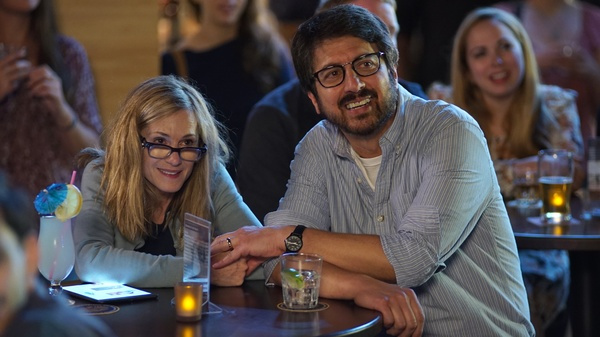Blueprints: "The Big Sick"
 Thursday, January 4, 2018 at 3:33PM
Thursday, January 4, 2018 at 3:33PM This week Jorge dives into one of the WGA Nominees and looks at how this screenplay gives its supporting characters a chance to shine.

At its heart, The Big Sick is the story of Kumail and Emily falling in love, falling out of love, and finding each other again. But it's more than a romantic comedy. It’s also a story about the people around Kumail, once Emily falls into a coma and the main relationship is no longer functional. It’s a movie where the supporting cast do more than merely support the lead’s love story; they actually get the chance to be developed into fully fleshed-out characters.
Let’s take a look at one of the most memorable moments in the movie, where a supporting character (Holly Hunter’s brilliantly defined Beth) takes a step into the spotlight, and grabs it...
The Big Sick
Written by: Emily V. Gordon and Kumail Nanjiani
[You can read the full script here. I will be talking about these pages and this scene.]
It’s an implicit rule of the rom-com genre that the central couple's world need to be populated with colorful supporting characters (the bubbly best friend, the reluctant parents, the too-present ex), that inform or revolve around the main relationship. But these players rarely have stories or issues of their own, forever destined to merely root for or fight against the couple’s love.
Much of the praise for The Big Sick has fallen into two areas: the screenplay by the real life married couple the movie is about and Holly Hunter’s supporting performance as Beth, the leading lady's mother. And rightly so.
The Big Sick is a rom-com that is only a rom-com up to a certain point. After that it becomes a film about vastly different people trying to find common ground where there initially seems to be none. Beth, Emily's mother, is the main force resisting Kumail; she doesn’t want him around, she knows that he deeply hurt her daughter. But they are forced to stay together. And through co-habitation usually comes understanding. And then Beth’s position changes in a stand-up show.
This scene is the first moment in the movie where Beth takes Kumail’s side; where she realizes that they may be in the same boat after all. All it took was an even stronger force opposing him, in the form of a heckling fraternity guy.

What the script does brilliantly is that Beth’s turning point doesn’t actually turn her. Her core attitude of resistance and defensiveness against someone that she cares about doesn’t change, it’s just re-directed.
It is also a moment of stress relief and cathartic explosion for Beth. She just goes on and on after the heckler, not giving him a chance to breathe. She hasn’t had a chance to breathe, either. And once she’s up and running, there’s no stopping her.
The script describes this scene very simply, with almost no directions, and short back-and-forth exchanges between Beth, the heckler, and Kumail, who acts (as he does in most of the movie) as the mediator. But it’s Hunter’s performance that enhances the dialogue with the baggage of emotion behind it; of being physically and emotionally exhausted, of catharsis, or realizing she actually cares about this guy that her daughter also cared about. All at the same time.

***

The mini-scene immediately afterwards, of the three of them in the car quietly heading home, also speaks volumes. It’s the first time the three of them are actually together in something.
The Big Sick is the rare romantic comedy that lets its supporting characters breathe and exist past the one-dimensional role of revolving around the leads’ romance. By removing the love story (and having half of the couple literally unconscious), Nanjiani and Gordon let the rest of the characters develop as fully-fleshed people. People that are hurt, people that are fed up, people that will fight you in a comedy club.



Reader Comments (2)
FIRST!
I loved this movie, and am due to watch it again; however, I honestly didn't completely buy this scene and thought Beth's change was a bit too abrupt. The winningness of everyone involved (Kumail, Holly, and stealth Best Supporting Actor contender Ray) made this scene work, but I think there were better moments in the wonderful screenplay.
A terrific script, brought to life by beautiful acting. So many gorgeous vignettes. One of the Top Ten films this year.